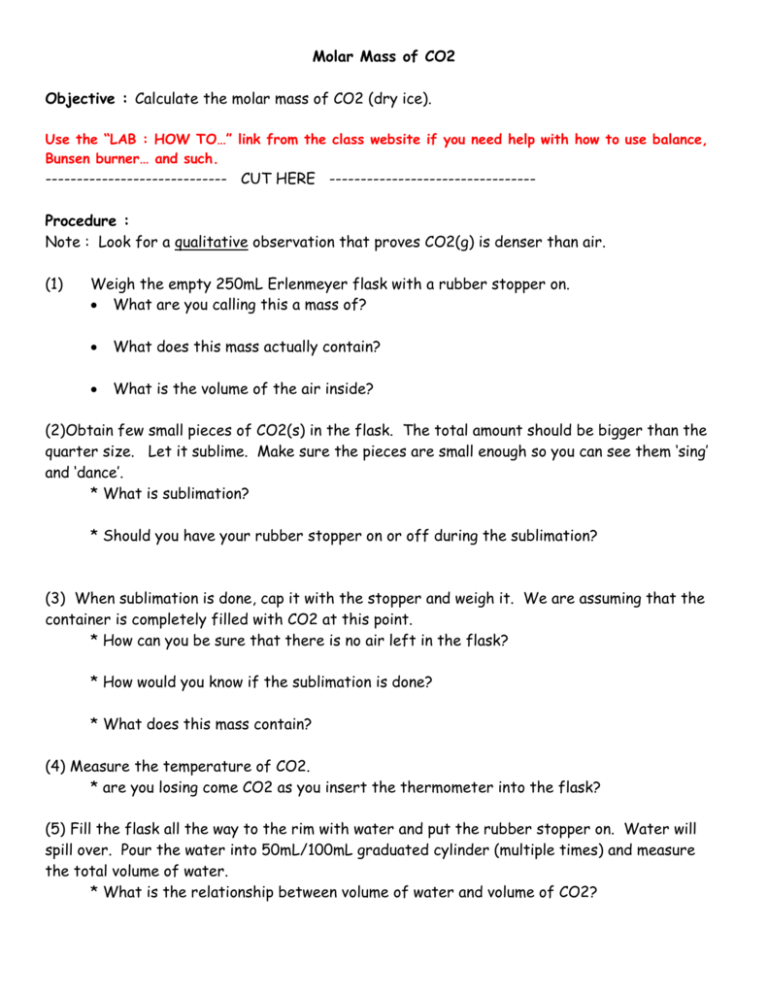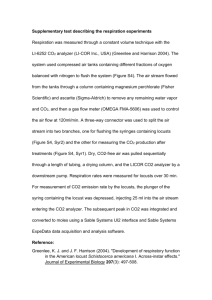Molar Mass CO2
advertisement

Molar Mass of CO2 Objective : Calculate the molar mass of CO2 (dry ice). Use the “LAB : HOW TO…” link from the class website if you need help with how to use balance, Bunsen burner… and such. ----------------------------- CUT HERE --------------------------------Procedure : Note : Look for a qualitative observation that proves CO2(g) is denser than air. (1) Weigh the empty 250mL Erlenmeyer flask with a rubber stopper on. What are you calling this a mass of? What does this mass actually contain? What is the volume of the air inside? (2)Obtain few small pieces of CO2(s) in the flask. The total amount should be bigger than the quarter size. Let it sublime. Make sure the pieces are small enough so you can see them ‘sing’ and ‘dance’. * What is sublimation? * Should you have your rubber stopper on or off during the sublimation? (3) When sublimation is done, cap it with the stopper and weigh it. We are assuming that the container is completely filled with CO2 at this point. * How can you be sure that there is no air left in the flask? * How would you know if the sublimation is done? * What does this mass contain? (4) Measure the temperature of CO2. * are you losing come CO2 as you insert the thermometer into the flask? (5) Fill the flask all the way to the rim with water and put the rubber stopper on. Water will spill over. Pour the water into 50mL/100mL graduated cylinder (multiple times) and measure the total volume of water. * What is the relationship between volume of water and volume of CO2? (6) Measure pressure of the air using the barometer on the wall. I will show a group of you how to read the barometer and your group will show another group and so on.... * you are going to assume that the air pressure is equal to the CO2 pressure inside of flask. How/ When is this possible? Did you look for a qualitative observation that proves CO2(g) is denser than air? ----------------------------- CUT HERE --------------------------------- Prelab Questions : (PL1) Which is more dense, CO2(g) or air? How do you know at this point? (PL2) What is the molar mass of a compound if 2.600g of this gas filled 950.0mL of volume at 30.5C and 700.0Torr? Cleary show your work. Analysis : (A1) Calculate the moles of CO2 using PV=nRT. (A2) Calculate the molar mass of CO2. Postlab Questions : (Q1) Which is more dense, CO2(g) or air? What is your qualitative proof? (Q2) What’s making the small pieces of CO2 “sing and dance”? (Q3) What would happen to the final result if the CO2(s) sample was too large (more than enough) to fill the flask ? (Q4) What would happen to the final result if the CO2(s) sample was too small (not enough) to fill the flask? (Q5) What would happen to the final result if you measure the room temperature (which is higher) instead of CO2 temperature? (Q6) In step (1), the ‘empty’ flask actually contains air. If the density of air was given to be 0.00115g/mL, recalculate the molar mass of CO2. You need to calculate the mass of air. (Q7) Compare the molar mass from analysis2 with Q6 Which one is more accurate? What causes them to be different? Summary : Report the unit used in your latest calculation. For example, if 0C is measured but K is used in the calculation, report in K. Mass ______ Temperature ______ Volume _________ Pressure _______ R ______ Molar mass of CO2 ________ (from analysis) Molar mass of CO2 _______ (from Q6) Theoretical molar mass of CO2 ______ Reflection Statement: One thing I might do differently next time is …… because…….







